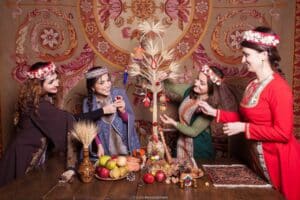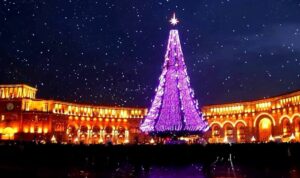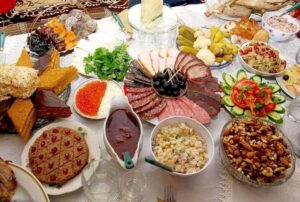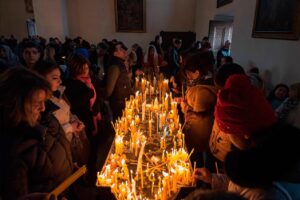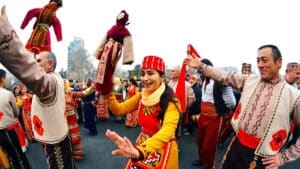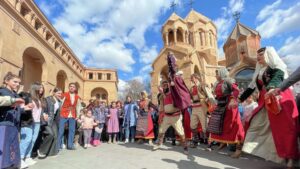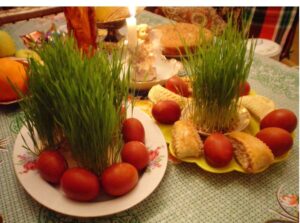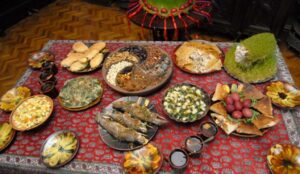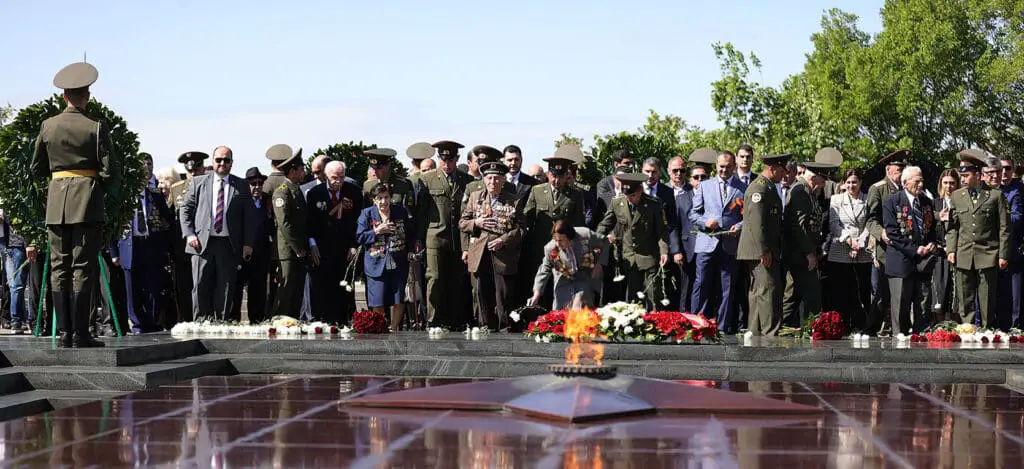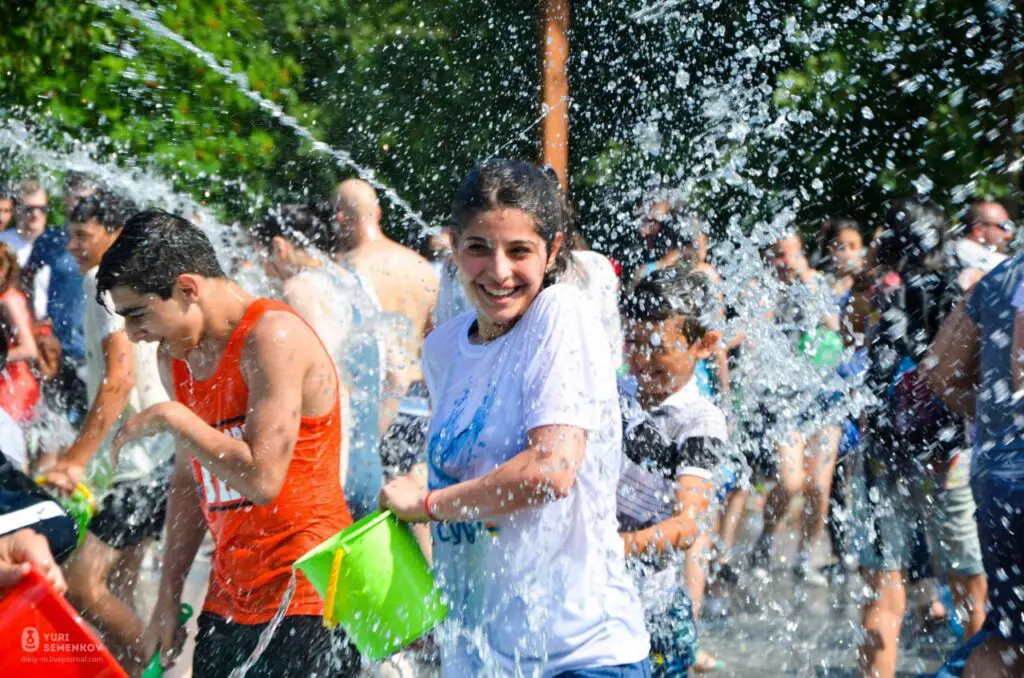Through these holidays, you will find Armenia is filled with a rich history revolving around nationhood, family, and religious tradition. Many holidays are particularly associated with specific monuments emphasizing the importance of place in Armenian culture. Some are ancient holidays steeped in pagan symbolism, officially repressed under the Soviets, but now newly embraced by the Armenian people, state, and even church as expressions of Armenian culture and identity. Finally, many holidays also now bare the scars of Armenia’s very recent pain in losing the Second Karabakh War.
Days Off
Long Weekends and Extra Days Off by Semester in 2026
| Spring | Summer | Fall | Winter |
| March 8 April 10-13, 24 May 1, 8, 9, 28 |
July 5 | September 13, 21 | January 1, 2, 6, 28 |
New Year’s Eve and New Year’s Day
in Armenian: Ամանոր
Evening of December 31 – January 2, 2026
Public holiday
(days off: Dec 31, 2025 – Jan 2, 2026)
The New Year’s main symbol is a decorated holiday tree. This is common throughout the former USSR. On New Year’s Eve, a grand dinner is served involving many appetizers and salads that are meant to be eaten throughout the evening between toasts to each other’s health. The dinner features a large assortment of foods from dried and fresh fruit, pickled and fresh vegetable salads, and various meats and cheeses. Breads such as lavash (Armenian flatbread) and choreg (an eggy brioche bread that is often served on holidays) are also common.
New Year is also the year’s major gift giving holiday. Armenia’s version of Santa Claus, known as Gaghant Baba, arrives on New Year’s to deliver presents to children.
At home is the most popular place to ring in the holiday, but there are also public celebrations, especially in major public spaces like Republic Square in Yerevan. Public squares are decorated with holiday decorations and New Year’s trees. Fireworks are set off to mark the occasion as well.
In the last couple of minutes of the old year, the Prime Minister will make a quick, televised speech and then the whole nation can watch the large clock on Republic Square tick down the last few seconds before the new year.
Usually, four days off are given for New Year, followed by a single workday and then another two days are taken off for Armenia’s Christmas. Often, people will take the single workday off, making the full holiday a week-long celebration to be spent with friends and family.
For more on how this important holiday is celebrated, see this article on our site.
Christmas and Epiphany
in Armenian: Սուրբ Ծնունդ և Աստվածահայտնություն
January 6, 2026
Public holiday
(days off: Jan 6, 2026)
Christmas in Armenia is a purely religiously focused holiday. Christmas is sometimes marked by the exchange of small gifts, especially sweets for children, but its focus is always on the religious aspect of the holiday.
While the West celebrates Christmas on December 25 and most Orthodox Churches celebrate on January 7th, the Armenian Apostolic Church celebrates on January 6, which the church holds is the original date, as celebrated until the fourth century when it was moved to override a pagan festival celebrating the birth of the sun. The Armenian Apostolic Church also holds that Jesus was baptized on this day and thus both Christmas and Ephiphany are celebrated together.
Leading up to Christmas, religious Armenians may fast, subsisting on a vegan diet without alcohol. Christmas eve dinner, known as Khetum in Armenia, will generally be light to ease the stomach off the fast and prepare it for the larger Christmas dinner. Khetum typically features rice, fish, nevik (made from green chard and chickpeas), and tanbur (a soup of yogurt and wheat). The dinner is eaten before attending a Divine Liturgy that marks Christmas Eve.
On January 6th, Armenians attend church services to celebrate the birth and baptism of Christ. As part of this, the faithful participate in a ritual lighting of candles that symbolizes Christ’s manifestation as the son of God. After the services, families gather for a festive meal that breaks the fast and includes traditional Armenian dishes such as khash, dolma, basturma, and lavash bread. Desserts such as gata, a sweet pastry, and anoush abour (a type of pudding made of fruit and barley) are also commonly served. Wine is a staple of the meal.
The main services are held at the Mother Cathedral of Holy Etchmiadzin, which is the spiritual center of the Armenian Apostolic Church. Often televised, they are often attended by major politicians and cultural figures as well.
National Army Day
in Armenian: Բանակի օր
January 28, 2026
Public holiday
(day off: Jan 28, 2026)
Army day was first observed in 2001 when Army Day was officially signed into law as an official holiday and non-working day. The Armenian armed forces were established on the 28th of January in 1992, shortly after the fall of the Soviet Union. This holiday commemorates the formation of the armed forces of the Independent Republic of Armenia in 1992.
The Armenian Apostolic Church traditionally holds an awards ceremony on this day. Its leader, currently Catholicos Garegin II, will present Orders of St. Nerses the Gracious, a major church award that recognizes an Armenian saint most known for his efforts to promote peace and reconciliation in military and religious matters.
A major state event is traditionally held at the Yerablur memorial in the Yerablur military cemetery on a hilltop on the outskirts of Yerevan. Yerablur is best known as the gravesite for those soldiers who have died in the Nagorno-Karabakh conflict.
Additionally, on this day there is usually a parade in Yerevan and a ceremony to commemorate and honor those who serve in the military.
Since the 2020 Second Nagorno-Karabakh war, celebrations have been lower key. The military and its command have become a politically sensitive topic as politicians and military leadership trade blame for Armenia’s defeat in the war.
Bun Barekendan
in Armenian: Բուն Բարեկենդան
February 15, 2026
(not a day off)
Bun Barekendan is celebrated on the eve of Lent. “Bun Barekendan” roughly translates to “the great good life.” Interestingly, this name is not dissimilar to the ancient, colorful, food-soaked holidays of other cultures that also observe Lent. Mardi Gras, for instance, is French for “Fat Tuesday” and Maslenitsa is likely an old Slavic corruption of “Butter Week.”
In all these cultures, including the Armenian, this is a holiday steeped in pagan tradition that is mean to embrace worldly pleasures and free-spirited human bliss before the Great Lent, which brings 48 days of abstinence and fasting.
Although many of the holiday’s traditions predate Christianity and recall pagan festivals, the Armenian Apostolic Church has embraced the holiday. A special mass is held the night before the celebration to officially open the festivities and priests can often be seen in open attendance and will even host press conferences to convey their interpretation of the holiday. The most common Biblical quote for the day is from 1 Kings 19:7, when the angel tells the Prophet Elijah “Arise and eat, otherwise the journey will be too great for you.” Church officials also teach that the holiday is a reminder of the bliss that Adam and Eve lived in before original sin cast them from the Garden of Eden.
Under the Soviets, the holiday was officially repressed. However, as Armenians have sought to revive their independent national identity, the traditions of Bun Barekendan have found considerable official support. The main celebrations are always held in Yerevan although in recent years NGOs and state funds have encouraged various cities and villages to host celebrations and encouraged local and international tourist flows to attend them.
Some festivities include games, festivals, carnivals, and large feasts.
Armenian national dress, music, and dancing can be seen everywhere during these celebrations. People will sometimes wear masks or carry representations of monsters, which are supposed to scare away bad spirits and bad luck. The masks also come from the original pagan tradition of wearing the mask of an animal to possess the animal’s supernatural powers.
International Women’s Day
in Armenian: Կանանց տոն
March 8, 2026
Public holiday
(day off: Mar 8, 2026)
International Women’s Day has been recognized since 1921 in Armenia, when it was made a holiday under the former USSR. Historically, the holiday is in remembrance of a March 8, 1917, strike in Saint Petersburg, where women demanded better working conditions and more access to food during the shortages of WWI. The holiday is for working women to take the day off and enjoy the time to relax and be celebrated by their family.
On this day, women are given gifts by the men in their lives – and often by random men and boys on the street. Most commonly, they are given flowers. Armenia’s streets will bloom with vendors who pop up to meet the massive spike in demand. Other common gifts include chocolate, perfume, and jewelry. The holiday has been significantly commercialized in Armenia with many stores, cafes, restaurants, and other businesses offering specials and sales for the holiday.
In recent times, some women have also taken the day to march for greater women’s rights in Armenia.
Day of Motherhood and Beauty
in Armenian: Մայրության և գեղեցկության օր
April 7, 2026
(not a day off)

The Day of Motherhood and Beauty in Armenia is roughly equivalent to Mother’s Day in America. It carries an additional religious aspect as well as this day was purposefully placed on top of the Armenian Apostolic Church’s Feast of the Annunciation of the Virgin Mary, which celebrates the day when it is believe that the angel Gabriel visited the Virgin Mary to tell her that she would be the mother of Jesus.
This day is not a day off, but is celebrated similarly to International Women’s Day, but with mothers as the specific focus. With Women’s Day, it bookends a month that Armenians associate with the celebration of women.
Easter and Easter Monday
in Armenian: Զատիկ
April 5 – April 6, 2026
Public holiday
(day off: April 5 – April 6, 2026)
Easter is known as Surb Zatik in Armenian, a phrase that translates to “Holy Easter.” Easter is also known as the Feast of the Resurrection, and its celebration focuses on the resurrection of Jesus and the removal of sin. This holiday is the most important on the calendar of the Armenian Apostolic Church.
Although the dates for both the Armenian Apostolic Church and most Western churches are calculated using a similar set of rules, the main difference is that Armenian Church calculates the date based on the Julian calendar, which is more than a week off from the Gregorian calendar, the one most of the world now uses.
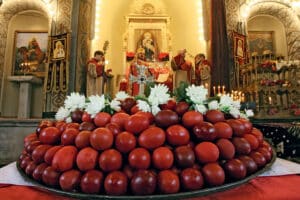
Easter, for religious Armenians, is preceded by Great Lent, a 40-day fast that should be vegan and alcohol-free. The week before Easter is called Holy Week and begins with Lazarus Saturday, which commemorates the day when it is believed that Jesus resurrected Lazarus, foreshadowing his own resurrection. Each preceding day commemorates a different event in the life of Jesus.
At the start of the Lenten fast, many Armenians will place lentils or other grains on a tray with moist cotton. The green sprouts that will form by Easter are used to decorate the table as a symbol of renewed life. Interestingly, this unique custom is shared with many surrounding Muslim countries as part of the spring New Year Navruz.
The day before Easter, on Holy Saturday, a special church service is held called the Lighting of the Candles, during which the Holy Fire is passed from person to person, symbolizing the resurrection of Jesus Christ. After the church service, people try to bring the lit candle home so as to have a piece of the holy light to add to their homes. Church goers will bring baskets filled with Easter eggs, which are traditionally dyed red using red onion skins to represent the blood of Christ. The basket will often have choreg, the sprouted grains, cheese, and other foods and/or items as well. All are sanctified in preparation for Easter dinner.
On Easter Sunday, the Apostolic Church holds Easter services and, after this, the great fast is broken with a festive meal. Traditional dishes eaten for Easter in Armenia are all symbolic. Lamb or fish is often served as a representation of the flesh of Christ, who is often referred to as the lamb of God. It is accompanied by red wine to symbolize the blood Christ shed for the sins of mankind. Plov is served with raisins, with the contrast of light and dark meant to symbolize that humanity that was saved by Christ’s sacrifice. Lastly, choreg, a sweet brioche bread that is often served for holidays in Armenia, is related to the mystical kulich that is eaten in many other former Soviet countries. In some places in Armenia, gata is preferred. Gata is a pastry filled or layered with honey or thick syrup and sometimes nuts.
The eggs are also used in an egg-tapping game. In the game you tap your egg with some else and whoever doesn’t crack wins the other egg. The person at the end of the game with the most eggs wins. Many children participate in the game, but adults tend to join in as well.
The Armenian traditional greeting on Easter is “Krisdos haryal i merelots” (Christ is risen from the dead), to which the reply is “Orhnyal e harutyun’ Krisdosi” (Blessed is the resurrection of Christ).
As with Christmas celebrations, the main Easter service is held at the Mother Cathedral of Holy Etchmiadzin, which is the spiritual center of the Armenian Apostolic Church and led by the catholicos, the head of the church. Services are often attended by major politicians and cultural figures.
On the Monday after Easter, Armenian families visit the graves of loved ones, in an event called “Merelotz,” or “Day of the Dead.” They will often have whole meals in the graveyard, sometimes leaving food on the graves, in a joyous celebration of the memory of the departed. Choreg and eggs are staples of the event as is greeting the graves with the words “Krisdos haryav ee merelotz!” (Christ is alive and well!).
Genocide Remembrance Day
in Armenian: Եղեռնի զոհերի հիշատակի օր
April 24, 2026
Public holiday
(day off: Apr 24, 2026)
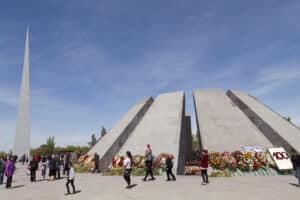
This Remembrance Day highlights the beginning of the massacre of Armenians in 1915 by the Ottomans in modern day Istanbul. In a series of massacres, more than one million Armenians were killed by 1918, equating to about 70 percent of the Armenian population within the Ottoman Empire.
The day is marked by major events in Armenia and other locations with a large Armenian population. Yerevan hosts a march that is attended by thousands and used to memorialize the dead but to also vent anger at Turkey, which Armenians hold accountable for the events as the successor state of the Ottoman Empire. Turkey denies that the deaths constitute a genocide although Armenia has garnered wide international approval for the use of the term.
The Tsitsernakaberd Genocide Memorial also hosts solemn events to mourn the victims, with people bringing flowers to its eternal flame. Others may commemorate through their art around the world, not just in Armenia.
Other common events to mark the day include art installations, documentary showings, plays and more.
Labor Day
in Armenian: Աշխատանքի օր
May 1, 2026
Public holiday
(day off: May 1, 2026)
Labor Day is a public holiday where business and schools are closed. This holiday was introduced in Armenia under the USSR, when it was celebrated as a major holiday. Today, while some sporadic demonstrations might be held by Armenia’s remaining (and mostly aging) communists, the holiday is a very low-key day of people just enjoying a day off.
Defenders of the Land Day
in Armenian: Երկրապահի օր
May 8, 2026
Public holiday
(day off: May 8, 2026)
Defenders of the Land Day is known as “Yerkrapah Day” in Armenia and commemorates an influential veterans’ group whose members helped fight to win the culturally important city of Sushi in the First Nagorno-Karabakh War in 1992. This holiday was celebrated as a celebration of the military and veterans – almost as an extension of Victory and Peace Day (see below), which has long occurred on May 9. This May 8th holiday, however, has not been celebrated since 2020, after the city was lost to Azerbaijan again in the Second Nagorno-Karabakh War that year. Although still an official day off, its status is now in question.
Victory and Peace Day
in Armenian: Հաղթանակի և Խաղաղության տոն
May 9, 2026
Public holiday
(day off: May 9, 2026)
On May 9th Armenians celebrate a “Triple Holiday,” commemorating the victory of the great patriotic war, the liberation of Shushi, and the anniversary of the establishment of the Artsakh Defense Army. The events during this day generally commemorate the fallen heroes and encourage a new generation of bravery.
Although Armenia was not invaded during the war, between 300,000-500,000 Armenians served in WWII, including in high-ranking positions. About half of those that served did not return, or about 10-20% of Armenia’s population at the time. WWII ended for the USSR on May 9, 1945.
On May 9, 1991, Armenia captured Sushi, a major city in Nagorno-Karabakh. The victory is regarded as being pivotal to Armenia’s overall victory in the war. The same day is marked as founding of the Artsakh Defense Army.
Since the 1990’s, the significance of May 9 has been as much attached to WWII as to the Nagorno-Karabakh War. The holiday has been celebrated with large military parades, fireworks, laying flowers at war memorials, concerts, and a generally jubilant mood in Armenia.
The Second Nagorno-Karabakh War in 2020 left the holiday greatly changed, however, as Shushi was again captured and is now held by Azerbaijan. Further, Russia is largely seen by the Armenian public as having abandoned Armenia in the war, leaving some to call for Armenia to distance itself from Russia and, by extension, its Soviet past.
The May 9th celebrations of 2022 were marked by protests demanding a new liberation of Shushi. Prime Minister Nikol Pashinyan made a speech in which he argued that while the current situation should be mourned, the previous liberation of Shushi should still be celebrated as one of Armenia’s greatest historical achievements.
The holiday is likely to retain its ability to evoke strong emotions but what it will mean in the future to Armenian national identity will depend on how current events play out.
First Republic Day
in Armenian: Հանրապետության օր
May 28, 2026
Public holiday
(day off: May 28, 2026)
On May 28, 1918, the creation of the independent Republic of Armenia was announced. The first republic was formed due to multiple battlefield victories against the Turks, which invaded what was then part of the Russian empire in WWI. The Turks vanquished and the Russian empire fallen, Armenia enjoyed its first independent state since the 14th century.
Although the first republic was short lived, ending on December 1, 1920, when the Soviets invaded and occupied the country, it is still celebrated as a major achievement of the Armenian people.
Today, First Republic Day is most traditionally celebrated by visiting Sardarapat, where one oof the major battles with the Turkish army was fought and won. There is now a large monument there which serves as the backdrop for official ceremonies and speeches. Additionally, First Republic Day is celebrated with concerts, parades, fireworks, and parties.
Constitution Day
in Armenian: Սահմանադրության օր
July 5, 2026
Public holiday
(day off: Jul 5, 2026)
Armenia’s flag was created on the 28th of May 1918 during the First Republic.
On July 5th of 1995, Armenia adopted its first post-Soviet constitution. This is a significant day to commemorate Armenia’s formation as a democratic and sovereign state and defining Yerevan as its capital.
This day is celebrated by taking a break from work and school for the official national holiday. The celebration is met with speeches, ceremonies, and special events for its commemoration. This day is also celebrated as the Day of State Symbols. Thus, the flag, coat of arms, and the anthem are all proudly on display on this day.
Incidentally, the colors of Armenia’s flag are highly symbolic. The red signifies the Armenian Highlands and struggle for survival, the blue represents the will of the Armenian people to live in peace, and the orange signifies the talent and diligence of the people.
Vardavar
in Armenian: Վարդավառ
July 12, 2026
(not a day off)
Vardavar is Armenia’s midsummer festival. Midsummer festivals were common among ancient people and often survive in some form today. Vardavar translates loosely as “burning rose” and was originally celebrated, in part, by burning roses in honor of Astghik, an Armenian goddess of water, beauty, love, and fertility.
Combining fire and water in midsummer festivals is common and today the main aspect of Vardavar is that Armenia as a country turns into a giant water fight. On this day people spray water onto others or dump buckets of water from their balconies. It’s a fun summer celebration for what are usually very hot days and a time for kids and adults to play pranks by dumping water onto friends and strangers.
Today, Vardavar is also officially another name for the Feast of the Transfiguration of the Lord under the Armenian church. Church officials will carry out ceremonies in which they bless things with rose-infused holy water. Many also say that the holiday is celebrated in remembrance of Noah’s commandment that his descendants should sprinkle each other with water to regularly remember the flood.
In addition to the water throwing, there are also often national festivals of Armenian song, dance, and heritage held on this day.
Exaltation of the Holy Cross
in Armenian: Խաչվերաց
September 13, 2026
Public holiday
(day off: September 13, 2026)
According to Christian tradition, the “True Cross” is that on which Jesus was actually crucified – it is one of Christianity’s holiest relics. This artifact was stolen by the Persians in the 7th century before being recaptured by the Byzantines and brought back to its homeland in a triumphant march that passed through modern Armenia. This day commemorates the cross’s brief presence in Armenia and is celebrated by the Armenian Apostolic Church as one its highest holy days. A large cross, decorated in basil, is brought to a field and erected. Four priests move to the four corners of the field and cast a blessing that is meant to bless the entire world. Because the feast always falls on a Sunday, and because the holiday is declared an official public holiday in Armenia, the Monday following the feast is usually given as a day off.
Independence Day
in Armenian: Անկախության օր
September 21, 2026
Public holiday
(day off: September 21, 2026)
Armenia’s Independence Day remembers the day that Armenia declared independence from the Soviet Union in 1991.
Independence Day has usually been celebrated with colorful, festive celebrations. There is traditional Armenian dancing, and music performances. There are military parades and light shows. The most traditional place to spend the day is Yerevan Republic Square, watching performances and fireworks and be in ceremonial processions through the city. The day usually begins with a march past by army troops and ends with a military parade that includes tanks and military helicopters flying overhead.
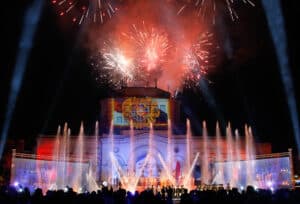
Like many other national holidays, Independence Day has been affected by the 2020 Second Nagorno-Karabakh War. Armenia’s Independence was fought for at the same time that the de-facto independence of Nagorno-Karabakh was fought for. The two struggles have always been intertwined in the Armenian national consciousness, with the former perhaps being even more prominent as it far more violent and costly.
After the war, many have protested having festive celebrations focused on the military when the military has recently experienced a costly defeat. Further, for many Armenians, the independence of both entities is intertwined and the loss of independence for one has diminished the independence for all.
Prime Minister Nikol Pashinyan made in speech in 2021 in which he tried to reconcile this new reality, saying that “History has shown and proved that victory in wars has not always been victory in general, in the same way, the defeat in wars has not always been defeat in general,” he said. “We must transform our defeat into victory, but we must also transform our formula for victory because history has shown that it is not always necessary to defeat others for a victory. To win means to overcome despair, to overcome hopelessness, to overcome fate, to overcome death.”
Earthquake Memorial Day
in Armenian: Երկրաշարժի զոհերի հիշատակի օր
December 7, 2026
(not a day off)
On December 7th of 1988, a massive earthquake affected about 40% of the territory of Armenia. The country’s soviet-built housing stock was particularly ill suited to the event and damage was widespread. Destruction occurred in 21 cities and 324 villages of Armenia, the city of Spitak and adjacent villages were destroyed, 80 percent of the buildings of Gyumri, the second largest city of Armenia were destroyed. According to official statistics, 25 thousand people died, 19 thousand became disabled, more than half a million were left homeless.
Today, many of the cities and villages have been rebuilt, in part due to a massive influx of aid that arrived from dozens of countries. All sites that were affected by the earthquake now have a memorial of some sort. On this day, ceremonies are often held at these memorials, including wreath laying by major politicians, to honor the victims.
More on Armenia

Armenian Talking Phrasebook
The Talking Phrasebook Series presents useful phrases and words in side-by-side translation and with audio files specifically geared to help students work on listening skills and pronunciation. Below, you will find several useful phrases and words. To the left is the English and to the above right is an English transliteration of the Armenian translation. […]
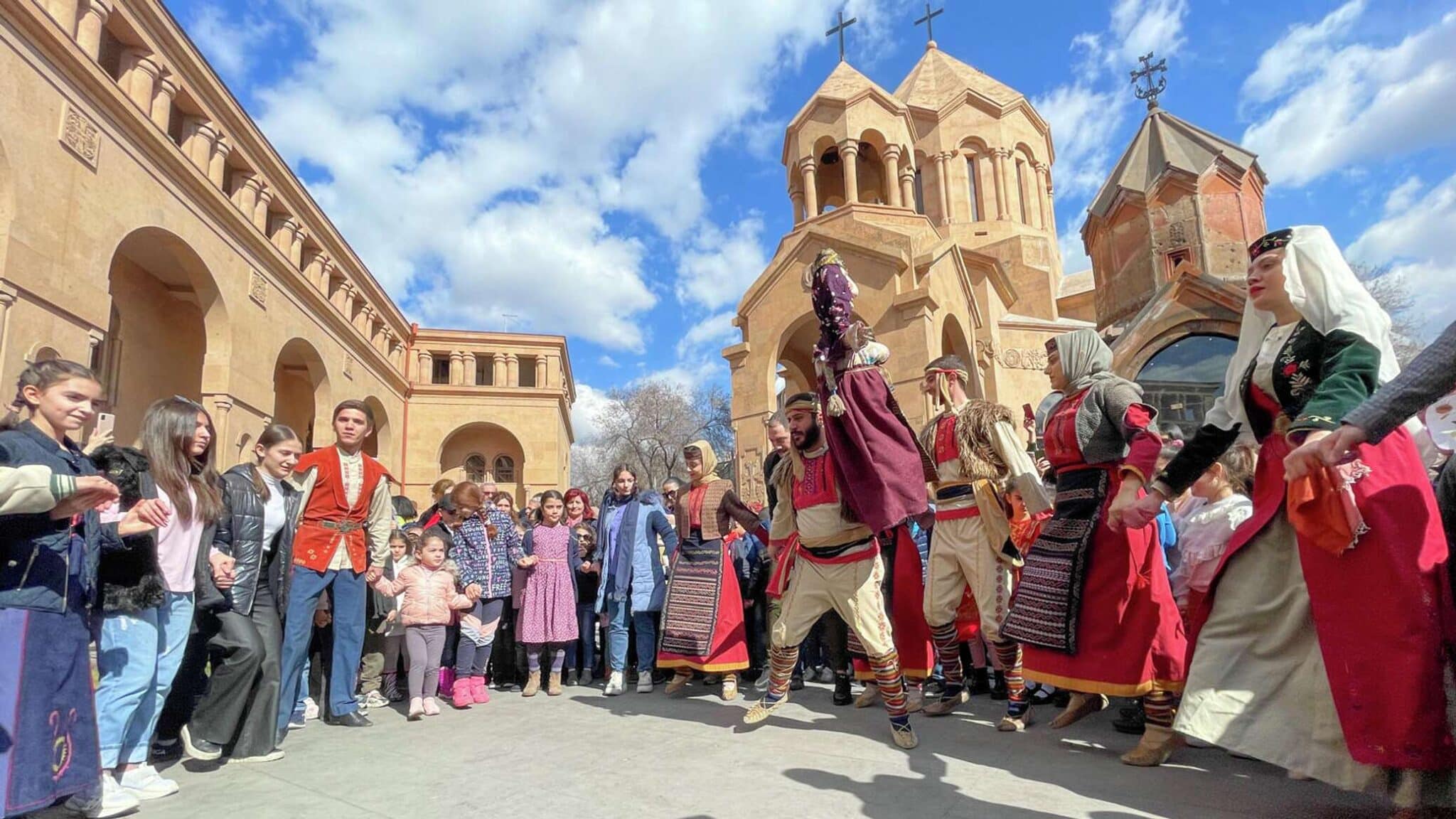
Armenian Holidays 2026: A Complete Guide
Through these holidays, you will find Armenia is filled with a rich history revolving around nationhood, family, and religious tradition. Many holidays are particularly associated with specific monuments emphasizing the importance of place in Armenian culture. Some are ancient holidays steeped in pagan symbolism, officially repressed under the Soviets, but now newly embraced by the […]
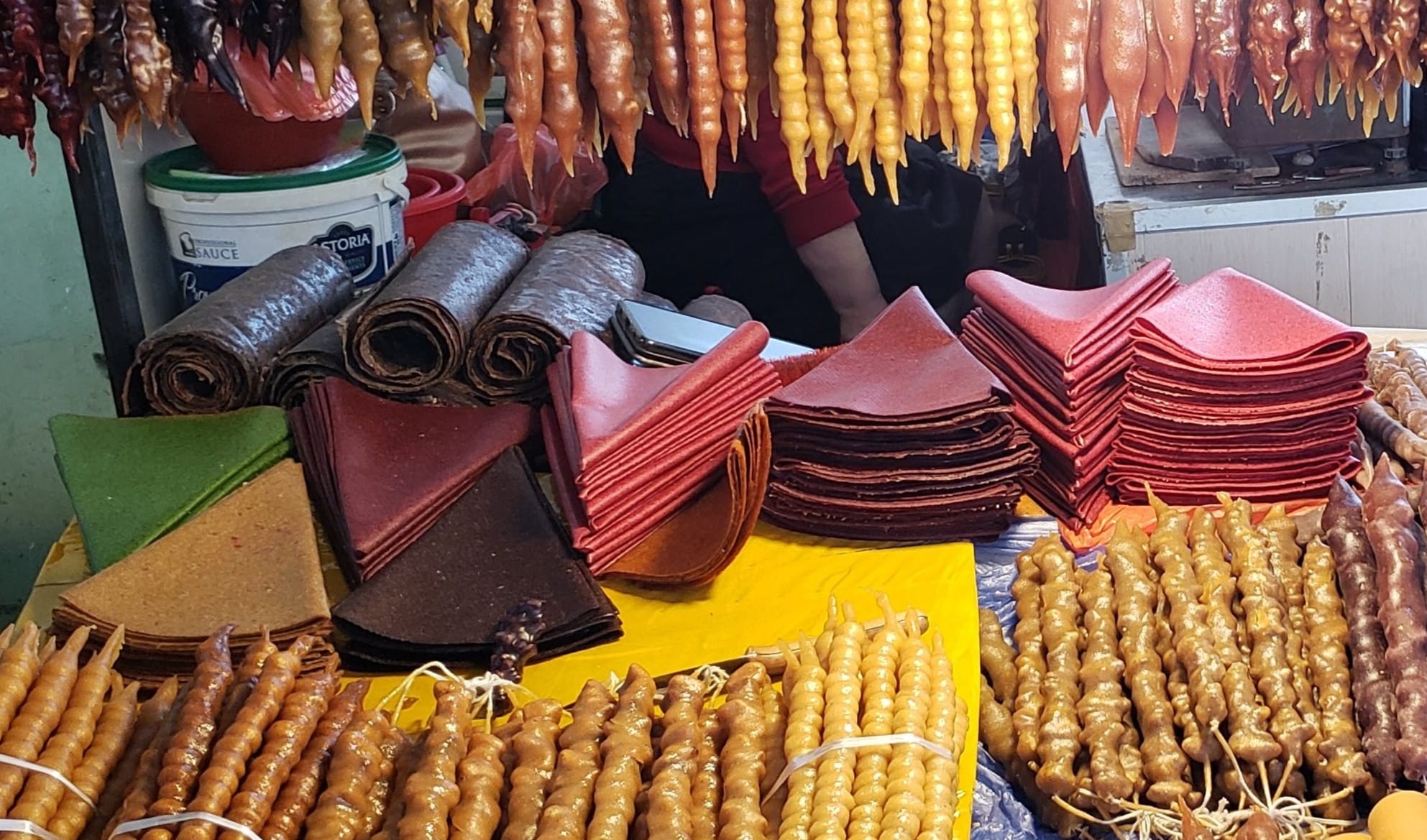
Tklapi, Pastegh, Lavashak: One Ingredient Fruit Leather from the Caucasus
Fruit leather is simple, ancient food. Like bread and roasted meat, it likely independently evolved in several places. At its most basic, it is simply mashed fruit smeared to a sheet and left to dry in the sun. The result is a flavor-intensive food that travels well and can keep for months. The oldest known […]
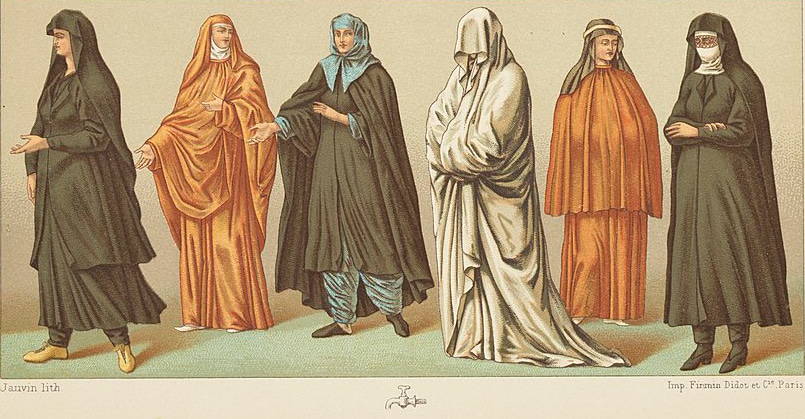
The Habits of Nuns in Catholic and Orthodox Traditions
Despite their cloistered livelihood, nuns have found their way into many veins of popular theater and movies. However, their usual depiction, wearing black habits with a veil and carrying a rosary, is not accurate for all nuns. It is true that the symbolic meaning of the habit is consistent across both Catholic and Eastern Orthodox […]
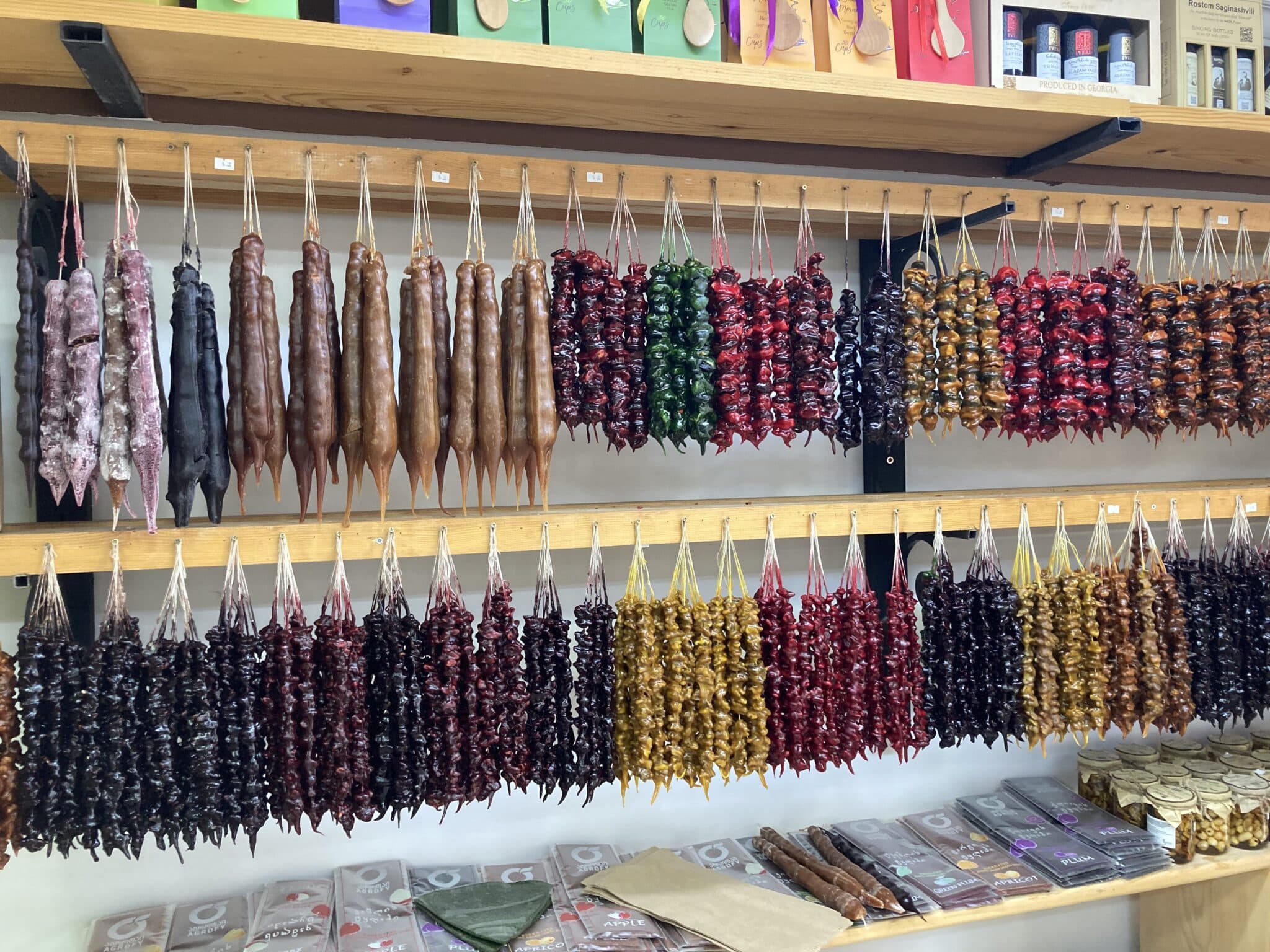
Churchkhela, Sharan, and Pelamushi: Desserts Off The Vine
Strolling through a marketplace in Georgia, you might be surprised to see the array of multicolored sausage-shaped candies hanging from the stalls. These are churchkhela, a traditional snack made by dipping strings of nuts into thickened fruit juice to create a chewy exterior. In Armenia, you’ll see “sausages” known locally as sharan that are very […]

